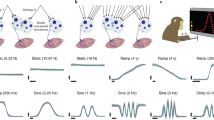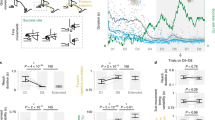Abstract
During motor skill acquisition, the brain learns a mapping between intended limb motion and requisite muscular forces. We propose that regions where sensory and motor representations overlap are crucial for motor learning. In primary motor cortex, for example, cells that modulate their activity for motor actions at a joint tend to receive input from that same portion of the periphery. We predict that this correspondence reflects a default strategy—a Bayesian prior—in which subjects tend to associate loads at a joint with motion at that joint (local sensorimotor association) when there is ambiguity regarding the nature of the load. As predicted, we found that in the presence of uncertainty, humans inappropriately generalized elbow loads as though they were based on elbow velocity. Generalization improved when we reduced uncertainty by decreasing coupling between elbow velocity and load during training. These results illustrate a key link between motor learning and the underlying neural circuitry.
This is a preview of subscription content, access via your institution
Access options
Subscribe to this journal
Receive 12 print issues and online access
$209.00 per year
only $17.42 per issue
Buy this article
- Purchase on Springer Link
- Instant access to full article PDF
Prices may be subject to local taxes which are calculated during checkout




Similar content being viewed by others
References
Shadmehr, R. & Mussa-Ivaldi, F.A. Adaptive representation of dynamics during learning of a motor task. J. Neurosci. 14, 3208–3224 (1994).
Lackner, J.R. & DiZio, P. Rapid adaptation to Coriolis force perturbations of arm trajectory. J. Neurophysiol. 72, 299–313 (1994).
Goodbody, S.J. & Wolpert, D.M. Temporal and amplitude generalization in motor learning. J. Neurophysiol. 79, 1825–1838 (1998).
Sainburg, R.L., Ghez, C. & Kalakanis, D. Intersegmental dynamics are controlled by sequential anticipatory, error correction, and postural mechanisms. J. Neurophysiol. 81, 1045–1056 (1999).
Imamizu, H. et al. Human cerebellar activity reflecting an acquired internal model of a new tool. Nature 403, 192–195 (2000).
Conditt, M.A., Gandolfo, F. & Mussa-Ivaldi, F.A. The motor system does not learn the dynamics of the arm by rote memorization of past experience. J. Neurophysiol. 78, 554–560 (1997).
Wolpert, D.M. & Ghahramani, Z. Computational principles of movement neuroscience. Nat. Neurosci. 3 (Suppl.), 1212–1217 (2000).
Vetter, P. & Wolpert, D.M. The CNS updates its context estimate in the absence of feedback. Neuroreport 11, 3783–3786 (2000).
Conditt, M.A. & Mussa-Ivaldi, F.A. Central representation of time during motor learning. Proc. Natl. Acad. Sci. USA 96, 11625–11630 (1999).
Murphy, J.T., Kwan, H.C., MacKay, W.A. & Wong, Y.C. Activity of primate precentral neurons during voluntary movements triggered by visual signals. Brain Res. 236, 429–449 (1982).
Scott, S.H. Comparison of onset time and magnitude of activity for proximal arm muscles and motor cortical cells before reaching movements. J. Neurophysiol. 77, 1016–1022 (1997).
Porter, R. & Lemon, R.N. Corticospinal Function & Voluntary Movement (Oxford Univ. Press, New York, 1993).
Asanuma, H. Functional role of sensory inputs to the motor cortex. Prog. Neurobiol. 16, 241–262 (1981).
Gibson, A.R., Robinson, F.R., Alam, J. & Houk, J.C. Somatotopic alignment between climbing fiber input and nuclear output of the cat intermediate cerebellum. J. Comp. Neurol. 260, 362–377 (1987).
Ghez, C. Input–output relations of the red nucleus in the cat. Brain Res. 98, 93–108 (1975).
Knill, D.C. & Richards, W. Perception as Bayesian Inference (Cambridge Univ. Press, New York, 1996).
Thoroughman, K.A. & Shadmehr, R. Learning of action through adaptive combination of motor primitives. Nature 407, 742–747 (2000).
Fitts, P.M. The information capacity of the human motor system in controlling the amplitude of movement. J. Exp. Psychol. 47, 381–391 (1954).
Ernst, M.O. & Banks, M.S. Humans integrate visual and haptic information in a statistically optimal fashion. Nature 415, 429–433 (2002).
Weiss, Y., Simoncelli, E.P. & Adelson, E.H. Motion illusions as optimal percepts. Nat. Neurosci. 5, 598–604 (2002).
Todorov, E. & Jordan, M.I. Optimal feedback control as a theory of motor coordination. Nat. Neurosci. 5, 1226–1235 (2002).
Drew, T. Motor cortical activity during voluntary gait modifications in the cat. I. Cells related to the forelimbs. J. Neurophysiol. 70, 179–199 (1993).
Scott, S.H. & Loeb, G.E. The computation of position sense from spindles in mono- and multi-articular muscles. J. Neurosci. 14, 7529–7540 (1994).
Hollerbach, M.J. & Flash, T. Dynamic interactions between limb segments during planar arm movement. Biol. Cybern. 44, 67–77 (1982).
Sainburg, R.L. & Kalakanis, D. Differences in control of limb dynamics during dominant and nondominant arm reaching. J. Neurophysiol. 83, 2661–2675 (2000).
Bastian, A.J., Martin, T.A., Keating, J.G. & Thach, W.T. Cerebellar ataxia: abnormal control of interaction torques across multiple joints. J. Neurophysiol. 76, 492–509 (1996).
Scott, S.H. Apparatus for measuring and perturbing shoulder and elbow joint positions and torques during reaching. J. Neurosci. Methods 89, 119–127 (1999).
Gribble, P.L. & Scott, S.H. Overlap of internal models in motor cortex for mechanical loads during reaching. Nature 417, 938–941 (2002).
Winter, D.A. Biomechanics and Motor Control of Human Movement (Wiley, New York, 1990).
Acknowledgements
The authors would like to thank D.M. Wolpert and J.R. Flanagan for valuable comments on the manuscript. Financial support was provided by the Natural Sciences and Engineering Research Council and start-up funds from the Faculty of Health Sciences at Queen's University. Salary funding was provided by a Canadian Institutes of Health Research (CIHR) Doctoral Award to K.S. and a CIHR Scholar Award to S.H.S.
Author information
Authors and Affiliations
Corresponding author
Ethics declarations
Competing interests
S.H.S. holds a US patent for the robotic device used in these experiments.
Rights and permissions
About this article
Cite this article
Singh, K., Scott, S. A motor learning strategy reflects neural circuitry for limb control. Nat Neurosci 6, 399–403 (2003). https://doi.org/10.1038/nn1026
Received:
Accepted:
Published:
Issue Date:
DOI: https://doi.org/10.1038/nn1026
This article is cited by
-
Quantitatively assessing aging effects in rapid motor behaviours: a cross-sectional study
Journal of NeuroEngineering and Rehabilitation (2022)
-
High intra-task and low inter-task correlations of motor skills in humans creates an individualized behavioural pattern
Scientific Reports (2022)
-
Cerebellar contribution to sensorimotor adaptation deficits in humans with spinal cord injury
Scientific Reports (2021)
-
Variable impact of tizanidine on the medium latency reflex of upper and lower limbs
Experimental Brain Research (2018)
-
Cortical representations of confidence in a visual perceptual decision
Nature Communications (2014)



